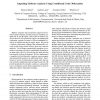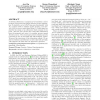142 search results - page 3 / 29 » Program obfuscation: a quantitative approach |
129
click to vote
SP
2005
IEEE
15 years 6 months ago
2005
IEEE
A malware detector is a system that attempts to determine whether a program has malicious intent. In order to evade detection, malware writers (hackers) frequently use obfuscation...
102
click to vote
CASES
2004
ACM
15 years 5 months ago
2004
ACM
+ With more applications being deployed on embedded platforms, software protection becomes increasingly important. This problem is crucial on embedded systems like financial transa...
111
Voted
NDSS
2008
IEEE
15 years 6 months ago
2008
IEEE
Malware programs that incorporate trigger-based behavior initiate malicious activities based on conditions satisfied only by specific inputs. State-of-the-art malware analyzers ...
126
Voted
DRM
2005
Springer
15 years 6 months ago
2005
Springer
A software obfuscator is a program O to transform a source program P for protection against malicious reverse engineering. O should be correct (O(P) has same functionality with P)...
105
Voted
POPL
2010
ACM
15 years 9 months ago
2010
ACM
We describe a new automatic static analysis for determining upper-bound functions on the use of quantitative resources for strict, higher-order, polymorphic, recursive programs de...


